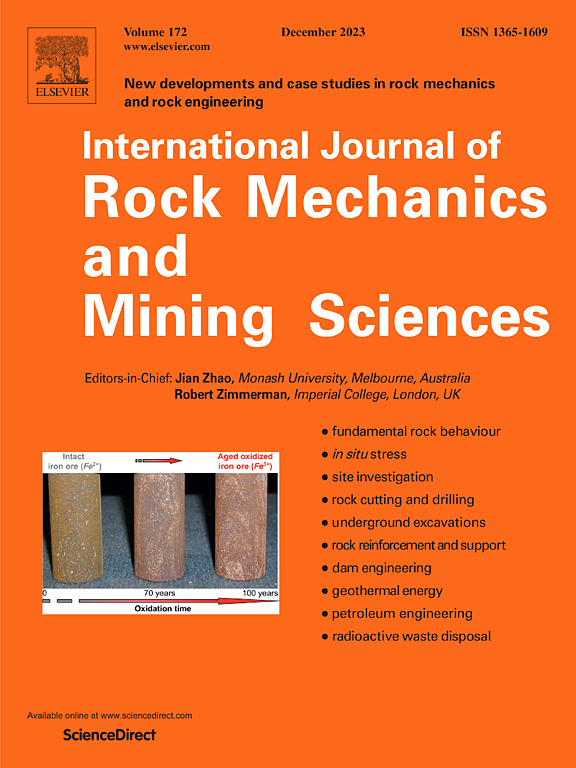一种基于液体超润滑的减轻断层滑动动力灾害的新方法
IF 7
1区 工程技术
Q1 ENGINEERING, GEOLOGICAL
International Journal of Rock Mechanics and Mining Sciences
Pub Date : 2025-02-01
DOI:10.1016/j.ijrmms.2025.106033
引用次数: 0
摘要
地震活动和岩爆等由断层滑动引起的动力灾害给各种地下工程项目带来了重大风险,目前使用的缓解方法往往涉及及时调节断裂面附近围岩的地应力策略。在此,我们提出了一种基于液体超润滑原理,从减少断层摩擦的角度来减轻断层滑动诱发的动力灾害的替代策略。以去离子水(DW)、聚乙二醇(PEG)溶液、氧化石墨烯(GO涂层)、含氧化石墨烯添加剂的PEG (GO in PEG)和含氧化石墨烯添加剂的乙醇水溶液(GO in EA)为润滑剂,在故障试样上进行了一系列摩擦实验。实验结果表明,与干燥条件相比,DW、PEG溶液、GO涂层、PEG中的GO和EA中的GO分别使扁平和粗糙断层试样的摩擦系数分别降低3%和4%、46%和28%、62%和23%、74%和51%、62%和48%。通过微尺度摩擦试验和表面表征来阐明氧化石墨烯添加剂在聚乙二醇中的润滑机理。吸附的PEG薄膜和石墨烯层有效地承受了高压,表现出较低的剪切应力,并保持了相对粗糙的表面纹理。结果表明,在自然断层中注入润滑液调节摩擦系数可以有效控制断层滑动,降低动力灾害风险。本文章由计算机程序翻译,如有差异,请以英文原文为准。
A novel approach of mitigating fault-slip induced dynamic disasters based on liquid super-lubricity
Fault-slip induced dynamic disasters, such as seismicity and rockburst, pose significant risks to various subsurface engineering projects, and the currently used mitigation methods often involves strategies of modulating in-situ stresses in the surrounding rocks near fault planes timely. Here, we propose an alternative strategy for mitigating fault-slip induced dynamic disasters in terms of reducing friction of faults based on liquid super-lubricity principle. A series of friction experiments were conducted on fault specimens in which deionized water (DW), polyethylene glycol (PEG) solution, graphene oxide (GO coating), PEG with graphene oxide additives (GO in PEG) and ethyl alcohol aqueous solution with graphene oxide additives (GO in EA) were served as lubricants. The experimental results demonstrate that friction coefficients of flat and rough fault specimens were reduced by 3 % and 4 %, 46 % and 28 %, 62 % and 23 %, 74 % and 51 %, 62 % and 48 %, respectively, when lubricated by DW, PEG solution, GO coating, GO in PEG, and GO in EA compared to dry condition. Microscale friction tests and surface characterization were conducted to elucidate the lubrication mechanism of GO additives in PEG. The adsorbed PEG film and graphene layers on contact asperities effectively withstood high pressures, exhibiting low shear stress and preserving a relatively rough surface texture. The results suggest that injecting lubricant solutions into natural faults to modulate friction coefficients can effectively control fault slip and mitigate the risk of dynamic disasters.
求助全文
通过发布文献求助,成功后即可免费获取论文全文。
去求助
来源期刊
CiteScore
14.00
自引率
5.60%
发文量
196
审稿时长
18 weeks
期刊介绍:
The International Journal of Rock Mechanics and Mining Sciences focuses on original research, new developments, site measurements, and case studies within the fields of rock mechanics and rock engineering. Serving as an international platform, it showcases high-quality papers addressing rock mechanics and the application of its principles and techniques in mining and civil engineering projects situated on or within rock masses. These projects encompass a wide range, including slopes, open-pit mines, quarries, shafts, tunnels, caverns, underground mines, metro systems, dams, hydro-electric stations, geothermal energy, petroleum engineering, and radioactive waste disposal. The journal welcomes submissions on various topics, with particular interest in theoretical advancements, analytical and numerical methods, rock testing, site investigation, and case studies.

 求助内容:
求助内容: 应助结果提醒方式:
应助结果提醒方式:


